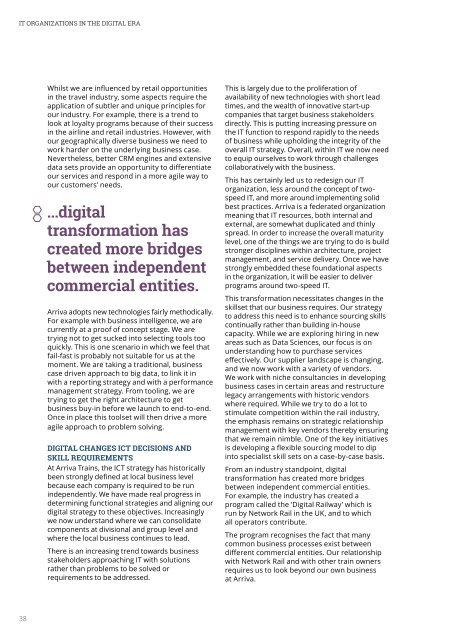IT Organizations in the Digital Era
ISG_Perspectives_Oct2016
ISG_Perspectives_Oct2016
Create successful ePaper yourself
Turn your PDF publications into a flip-book with our unique Google optimized e-Paper software.
<strong>IT</strong> ORGANIZATIONS IN THE DIG<strong>IT</strong>AL ERA<br />
Whilst we are <strong>in</strong>fluenced by retail opportunities<br />
<strong>in</strong> <strong>the</strong> travel <strong>in</strong>dustry, some aspects require <strong>the</strong><br />
application of subtler and unique pr<strong>in</strong>ciples for<br />
our <strong>in</strong>dustry. For example, <strong>the</strong>re is a trend to<br />
look at loyalty programs because of <strong>the</strong>ir success<br />
<strong>in</strong> <strong>the</strong> airl<strong>in</strong>e and retail <strong>in</strong>dustries. However, with<br />
our geographically diverse bus<strong>in</strong>ess we need to<br />
work harder on <strong>the</strong> underly<strong>in</strong>g bus<strong>in</strong>ess case.<br />
Never<strong>the</strong>less, better CRM eng<strong>in</strong>es and extensive<br />
data sets provide an opportunity to differentiate<br />
our services and respond <strong>in</strong> a more agile way to<br />
our customers’ needs.<br />
...digital<br />
transformation has<br />
created more bridges<br />
between <strong>in</strong>dependent<br />
commercial entities.<br />
Arriva adopts new technologies fairly methodically.<br />
For example with bus<strong>in</strong>ess <strong>in</strong>telligence, we are<br />
currently at a proof of concept stage. We are<br />
try<strong>in</strong>g not to get sucked <strong>in</strong>to select<strong>in</strong>g tools too<br />
quickly. This is one scenario <strong>in</strong> which we feel that<br />
fail-fast is probably not suitable for us at <strong>the</strong><br />
moment. We are tak<strong>in</strong>g a traditional, bus<strong>in</strong>ess<br />
case driven approach to big data, to l<strong>in</strong>k it <strong>in</strong><br />
with a report<strong>in</strong>g strategy and with a performance<br />
management strategy. From tool<strong>in</strong>g, we are<br />
try<strong>in</strong>g to get <strong>the</strong> right architecture to get<br />
bus<strong>in</strong>ess buy-<strong>in</strong> before we launch to end-to-end.<br />
Once <strong>in</strong> place this toolset will <strong>the</strong>n drive a more<br />
agile approach to problem solv<strong>in</strong>g.<br />
DIG<strong>IT</strong>AL CHANGES ICT DECISIONS AND<br />
SKILL REQUIREMENTS<br />
At Arriva Tra<strong>in</strong>s, <strong>the</strong> ICT strategy has historically<br />
been strongly def<strong>in</strong>ed at local bus<strong>in</strong>ess level<br />
because each company is required to be run<br />
<strong>in</strong>dependently. We have made real progress <strong>in</strong><br />
determ<strong>in</strong><strong>in</strong>g functional strategies and align<strong>in</strong>g our<br />
digital strategy to <strong>the</strong>se objectives. Increas<strong>in</strong>gly<br />
we now understand where we can consolidate<br />
components at divisional and group level and<br />
where <strong>the</strong> local bus<strong>in</strong>ess cont<strong>in</strong>ues to lead.<br />
There is an <strong>in</strong>creas<strong>in</strong>g trend towards bus<strong>in</strong>ess<br />
stakeholders approach<strong>in</strong>g <strong>IT</strong> with solutions<br />
ra<strong>the</strong>r than problems to be solved or<br />
requirements to be addressed.<br />
This is largely due to <strong>the</strong> proliferation of<br />
availability of new technologies with short lead<br />
times, and <strong>the</strong> wealth of <strong>in</strong>novative start-up<br />
companies that target bus<strong>in</strong>ess stakeholders<br />
directly. This is putt<strong>in</strong>g <strong>in</strong>creas<strong>in</strong>g pressure on<br />
<strong>the</strong> <strong>IT</strong> function to respond rapidly to <strong>the</strong> needs<br />
of bus<strong>in</strong>ess while uphold<strong>in</strong>g <strong>the</strong> <strong>in</strong>tegrity of <strong>the</strong><br />
overall <strong>IT</strong> strategy. Overall, with<strong>in</strong> <strong>IT</strong> we now need<br />
to equip ourselves to work through challenges<br />
collaboratively with <strong>the</strong> bus<strong>in</strong>ess.<br />
This has certa<strong>in</strong>ly led us to redesign our <strong>IT</strong><br />
organization, less around <strong>the</strong> concept of twospeed<br />
<strong>IT</strong>, and more around implement<strong>in</strong>g solid<br />
best practices. Arriva is a federated organization<br />
mean<strong>in</strong>g that <strong>IT</strong> resources, both <strong>in</strong>ternal and<br />
external, are somewhat duplicated and th<strong>in</strong>ly<br />
spread. In order to <strong>in</strong>crease <strong>the</strong> overall maturity<br />
level, one of <strong>the</strong> th<strong>in</strong>gs we are try<strong>in</strong>g to do is build<br />
stronger discipl<strong>in</strong>es with<strong>in</strong> architecture, project<br />
management, and service delivery. Once we have<br />
strongly embedded <strong>the</strong>se foundational aspects<br />
<strong>in</strong> <strong>the</strong> organization, it will be easier to deliver<br />
programs around two-speed <strong>IT</strong>.<br />
This transformation necessitates changes <strong>in</strong> <strong>the</strong><br />
skillset that our bus<strong>in</strong>ess requires. Our strategy<br />
to address this need is to enhance sourc<strong>in</strong>g skills<br />
cont<strong>in</strong>ually ra<strong>the</strong>r than build<strong>in</strong>g <strong>in</strong>-house<br />
capacity. While we are explor<strong>in</strong>g hir<strong>in</strong>g <strong>in</strong> new<br />
areas such as Data Sciences, our focus is on<br />
understand<strong>in</strong>g how to purchase services<br />
effectively. Our supplier landscape is chang<strong>in</strong>g,<br />
and we now work with a variety of vendors.<br />
We work with niche consultancies <strong>in</strong> develop<strong>in</strong>g<br />
bus<strong>in</strong>ess cases <strong>in</strong> certa<strong>in</strong> areas and restructure<br />
legacy arrangements with historic vendors<br />
where required. While we try to do a lot to<br />
stimulate competition with<strong>in</strong> <strong>the</strong> rail <strong>in</strong>dustry,<br />
<strong>the</strong> emphasis rema<strong>in</strong>s on strategic relationship<br />
management with key vendors <strong>the</strong>reby ensur<strong>in</strong>g<br />
that we rema<strong>in</strong> nimble. One of <strong>the</strong> key <strong>in</strong>itiatives<br />
is develop<strong>in</strong>g a flexible sourc<strong>in</strong>g model to dip<br />
<strong>in</strong>to specialist skill sets on a case-by-case basis.<br />
From an <strong>in</strong>dustry standpo<strong>in</strong>t, digital<br />
transformation has created more bridges<br />
between <strong>in</strong>dependent commercial entities.<br />
For example, <strong>the</strong> <strong>in</strong>dustry has created a<br />
program called <strong>the</strong> ‘<strong>Digital</strong> Railway’ which is<br />
run by Network Rail <strong>in</strong> <strong>the</strong> UK, and to which<br />
all operators contribute.<br />
The program recognises <strong>the</strong> fact that many<br />
common bus<strong>in</strong>ess processes exist between<br />
different commercial entities. Our relationship<br />
with Network Rail and with o<strong>the</strong>r tra<strong>in</strong> owners<br />
requires us to look beyond our own bus<strong>in</strong>ess<br />
at Arriva.<br />
38


